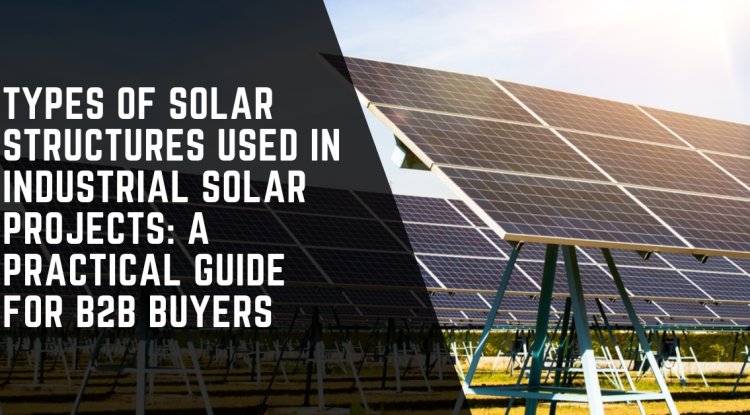Types of Solar Structures Used in Industrial Solar Projects: A Practical Guide for B2B Buyers
Category: Blogs

Introduction: Choosing the Right Solar Structure is More Than Just Engineering
Imagine this scenario:
You’re planning a large solar installation for a factory in Uttar Pradesh. The land is ready, the panels are selected, but one critical decision remains: what type of solar mounting structure will you choose?
This isn’t just a technical choice. The solar structure you pick impacts project costs, long-term maintenance, and energy output for decades to come.
For B2B buyers, project managers, and procurement professionals involved in industrial solar projects, understanding the different solar structure types is essential.
This guide will break down each option, explain where it works best, and help you avoid costly mistakes.
1. Fixed Tilt Solar Structures: The Reliable Workhorse
What Are Fixed Tilt Structures?
Fixed tilt solar structures hold solar panels at a pre-set angle, usually optimized based on the project’s geographic location (latitude). These systems don’t move; they stay in a fixed position throughout the year.
Why Choose Fixed Tilt?
|
Advantage |
Impact on Project |
|
Simple Installation |
Faster deployment, lower installation cost |
|
Minimal Maintenance |
No moving parts means fewer breakdowns |
|
Cost-Effective |
Lower CAPEX compared to tracking systems |
Where Are They Used?
Fixed tilt systems are common in:
-
Industrial solar parks
-
Utility-scale solar farms
-
Large open commercial land installations
If your priority is low upfront cost with proven performance, fixed tilt is often the go-to choice.
2. Tracking Systems: When Maximizing Output Matters
What Are Solar Trackers?
Tracking systems allow solar panels to follow the sun’s movement, increasing energy capture. There are two main types:
-
Single-Axis Trackers: Rotate east to west.
-
Dual-Axis Trackers: Adjust both horizontally and vertically for maximum sun exposure.
Why Use Trackers?
|
Advantage |
Impact on Project |
|
15–30% Higher Energy Output |
More energy means better ROI long-term |
|
Real-Time Optimization |
Panels face the sun throughout the day |
Where Are They Used?
Tracking systems are ideal for:
-
Utility-scale solar farms
-
Industrial projects in high-irradiation areas (e.g., Rajasthan, Gujarat)
Consider This:
If your project has strict ROI goals or you’re selling power under a PPA (Power Purchase Agreement), trackers often make financial sense, even with higher maintenance costs.
3. Rooftop Solar Structures: Make Use of Unused Space
What Are Rooftop Solar Structures?
These systems mount panels directly onto the roofs of industrial buildings, warehouses, or office complexes.
Why Choose Rooftop Solar?
|
Advantage |
Impact on Project |
|
Space Optimization |
Use the idle roof space for energy savings |
|
No Land Required |
Perfect for urban or space-limited sites |
|
Reduced Energy Bills |
Power on-site operations directly |
Where Are They Used?
Rooftop solar is popular in:
-
Factories
-
Warehouses
-
Corporate office buildings
Tip for Buyers:
Check the roof load-bearing capacity before procurement. Not all industrial roofs are ready for solar without reinforcement.
4. Ground-Mounted Solar Structures: Scalable and Flexible
What Are Ground-Mounted Systems?
These structures install directly into the ground using:
-
Concrete foundations
-
Driven piles
-
Screw anchors (for soft soil conditions)
Why Choose Ground-Mounted Systems?
|
Advantage |
Impact on Project |
|
Scalable Deployment |
Expand easily as your energy needs grow |
|
Flexible Orientation |
Position panels for maximum sun capture |
|
Easier Maintenance Access |
Simplified cleaning and repairs |
Where Are They Used?
Perfect for:
-
Factories with adjacent land
-
Large-scale solar farms
-
Industrial parks
Pro Tip:
In flood-prone areas, consider elevated ground mounts to prevent water damage.
Additional Factors to Consider When Choosing Solar Structures
Selecting the right solar mounting solution goes beyond just panel placement. Here are key considerations:
Site Conditions
-
Soil Stability: Determines if you’ll need concrete foundations or can use screw piles.
-
Wind Load & Weather: Essential for structural integrity, especially in coastal or high-wind areas.
Cost vs. Efficiency
|
Structure Type |
Cost |
Energy Output |
|
Fixed Tilt |
Lower |
Standard |
|
Tracking System |
Higher |
+15–30% Output |
|
Rooftop |
Moderate |
Depends on space |
Balance your CAPEX with long-term OPEX and energy yield goals.
Maintenance Requirements
|
Structure Type |
Maintenance Level |
|
Fixed Tilt |
Low |
|
Tracking System |
High (moving parts) |
|
Rooftop |
Low to Moderate |
|
Ground-Mounted |
Moderate |
Conclusion: The Right Solar Structure Is the Backbone of Your Project
The success of your industrial solar project depends heavily on choosing the right solar structure type. Each option—fixed tilt, trackers, rooftop systems, or ground-mounted—serves specific needs.
Before making a final decision, ask yourself:
-
What are my long-term energy output goals?
-
Is land or roof space available?
-
What’s my budget vs. expected return?
-
How much maintenance am I prepared for?
If you’re unsure, consult with experienced providers of solar mounting solutions to align your project requirements with the most suitable structure.
FAQs
Q1: What is the most cost-effective solar structure for industrial use?
A: Fixed tilt structures are usually the most cost-effective due to lower upfront costs and minimal maintenance.
Q2: Do tracking systems work well in all locations?
A: Trackers are best for regions with high direct sunlight. In cloudy or diffuse light regions, the benefits are less significant.
Q3: Can rooftop solar be used in heavy industries?
A: Yes, but ensure the roof can bear the load. Consult a structural engineer before installation.
Q4: What is the typical lifespan of solar mounting structures?
A: Most quality structures last 20–30 years, matching the lifespan of solar panels.
Q5: Are there hybrid systems that combine types?
A: Some projects use both ground-mounted and rooftop solar to maximize space utilization and energy yield.